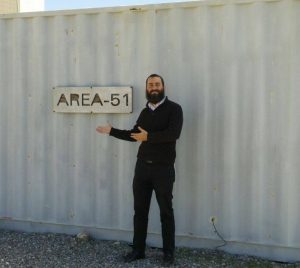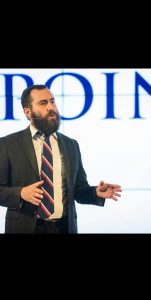Ever been intrigued by supernatural phenomena?
Have I got a rabbi for you.
Rabbi Pinchas Taylor is the director of adult education and outreach at the Chabad of Plantation, Florida. He is a life coach, teacher, speaker, and rabbi who began his spiritual journey at a very young age. He is also the author of The Jewish Guide to the Mysterious, (Mosaica Press, 2020).
Rabbi Taylor says that most people fall into one of two categories when it comes to the paranormal realm: either they are captivated by the idea, or they categorically reject it as nonsense.
But there is a third way, an approach that allows one to explore these topics and emerge with an appreciation for the depth of Hashem’s world, a balanced view that is the result of studying Torah sources on these subjects.
In the introduction to his book, Rabbi Taylor writes, “It has been said that Rabbi Yaakov Yisrael Kanievsky, the Steipler Gaon, zt”l, encouraged discussion about the paranormal because, at the very least, it would provoke thinking about there being more to existence than just the physical body and material world.”
In each chapter of this book, academic and historical perspectives are followed by, l’havdil, the Torah’s view on these phenomena. I was introduced to The Jewish Guide to the Mysterious by my Partner in Torah and was captivated by Rabbi Taylor’s well-researched presentation of each subject. I was also curious to know about the man behind the book.
Let’s discuss a little about your background. Were you always planning to be a rabbi?
I decided to become a rabbi at the age of 15, before I even became frum. I’m originally from Plantation, Florida. When I entered high school and began thinking about what I wanted to be, I thought, “Well, I love spirituality and Judaism. I love people, and I love learning and teaching. Rabbi seems like a good job to aim for.”
When I was seven, I went to the Chabad Hebrew school. Already at that age I wanted to become more religious. We’d order Domino’s pizza, and I’d say, “Let’s not order pepperoni.” My mom wasn’t against religion, but she thought it would be more appropriate to send me to a school that was more reflective of our lifestyle. I attended a Conservative Hebrew school until the age of 13. When I decided at age 15 that becoming a rabbi seemed like a good path for me, I began to explore the Conservative synagogue. I spent some time there but left after a short while. I didn’t find any satisfaction to the answers they provided to my questions, and I could not find the link between what they were teaching versus what they were doing. Why, for example, did it say in the Torah to eat kosher but we weren’t doing that? I migrated back to Chabad, where I’d had a brief, impactful history.
At that point, I wanted to transfer from public school to yeshivah, but my parents wanted me to complete high school. I graduated early, at the age of 17, and went from there to yeshiva in Morristown. After that, I spent six years at the Rabbinical College of America, and then a year in Los Angeles. I received semichah after a total of eight years of study. I began teaching in Morristown, but after I got married, I moved back to Florida, where I was hired to teach and do outreach at the very same Chabad center that I’d attended as a seven-year-old. That school had become very much a part of my life and growth. What better way is there to come full circle than to be hired by the very place that groomed me to become a Torah Jew?
Were you always interested in mysticism?
Yes. Spirituality was always interesting to me in any form. I went through a phase where I felt that Gemara, Halachah, and Chassidus were the only subjects worth studying. There are many people out there who, like I did for a time, reject mystical subjects. There are others who get too caught up in it and lose sight of real life. Generally, people fall into one of those two schools of thought. But as I’ve learned, there is a happy balance, a middle ground that allows you to retain a balanced view where you can appreciate these subjects without allowing them to become your focus.
There are misunderstandings even within the frum community about the topics in my book, and I’m hoping that people will be open to the idea that there is more to the world than we know. I started out fascinated by these subjects, and that was part of my own journey to becoming frum, the understanding that there’s more to reality than meets the eye. I think that a lot of people in the frum world are initially uninterested in what we might call paranormal subjects; they associate them with people who are kind of living in the clouds. In their minds, there are not a lot of rational associations to be made. When you explore these ideas with academic depth and try to take them apart without accepting or rejecting them, there’s a lot of interesting nuance that comes out of each subject.
Some people believe that their dreams are nevuah; others will disregard them completely. But there’s a happy medium. It’s interesting to see the whole picture come together, and it makes the concept more meaningful when you put together what science has to say versus Chassidic masters and rabbis.
There’s a story of an atheist who told a rabbi, “I don’t believe in G-d.” The rabbi answered. “The G-d that you don’t believe in is not the one I believe in either.” People’s ideas of demons, for example, are shaped by what they’ve seen in movies. That’s not something we believe in. But when you explore real sources about the subject, you get a better idea of the larger picture that is G-d’s created world, and that is very valuable.

Which came first, your research or your idea for the book?
I wrote my first book, Pillars of Faith, before this one, but it was not my initial intent to write a book. I began the writing process to satisfy my own quest for knowledge.
Throughout my journey, I read a lot of kiruv books. A lot of those books are broad-brushed and missing a lot of what I call “meat.” Some are dismissive of science, and others are too engaging. I don’t read any Torah book that doesn’t have good footnotes, even if it has good haskamos. I want to know: What does Chazal say? What does the Torah say? If there’s a statement, I want to see its source. I don’t like “feel good” books.
I wanted to give gain understanding through real explanation and honest assessment of foundational concepts such as free will, Mattan Torah, and Moshiach. I investigated each topic during a process that took more than four years and compiled my research in essays that were heavily footnoted. I had over 2000 footnotes by the time I was finished, each of which contained clear references to my sources. I had so much material that I said, “This can be a book.” Pillars of Faith was published in 2014.
I was very interested in dreams, so for the second book I started with that topic and went from there to other subjects that I felt were in the same category. The Jewish Guide to the Mysterious took four more years to compile.
There’s a vast amount of research presented in your book. How did you find your material?
I read a lot. Thank G-d for Amazon where you can get books for a dollar or less! I order books every week, earmarking what I like and what I might use it for. I can have ten books open at once as I do my research, looking at the footnotes and tracking down sources. I look up academic articles and will basically read any source I can find for the topic I’m researching.
Once you’re interested in a subject, it motivates you to keep going. I look forward to writing because I’m genuinely interested in what I’ll find out next.
Is everything in the book meant to be taken literally?
There’s a difference between taking something literally and accepting it as truth. I don’t think that Midrash is stam a story, but there can be several variations that are all true. For example, in the chapter about golems there is a footnote about the Malbim that explains that the calf Avraham served to the malachim was a calf that Avraham had created. That answers the question about how Avraham could have served butter at that meal. Now, Rashi says there that the butter was served first so there was no basar v’chalav, but both explanations can be true.
Anytime we use anthropomorphic terminology – such as G-d’s “arm” – we are using relatable terms to describe spiritual abilities. In the same vein, in a footnote at the beginning of the chapter on angels I explain that when malachim are described as having wings we are describing their ascension because the essence of a malach is to be climbing higher.
A girl in one of the seminary classes I teach once had questions about sheidim after watching a movie about demons. I told her, “You have much more to concerned about when it comes to damage from the movie to your neshamah than about sheidim.”

How did you choose what to put in and what to leave out?
I included what I found interesting. The editor at Mosaica Press, Doron Kornbluth, has written several books in his own right and does a great job at editing. He’d say, “This is too intricate,” or “Put a footnote here, it needs more explanation.” This book was originally supposed to be titled The Jewish Guide to the Paranormal but Doron said that no frum Jew will be able to relate to the word paranormal. He was the one who came up with the word “mysterious” for the title.
By the time I got to some of the topics, some of the material was redundant. If some analogies were already touched upon, I didn’t want to repeat them. If some chapters are shorter than others, that’s the reason.
I spoke to a Rav who read the first draft, and he said that it was well done, but he wished there could be a distinction between Torah and secular sources. I make mention of that in the introduction, that the footnotes are all lined up together for the sake of organizational purposes, not because they have the same value.
A lot of what we read is inconclusive. Did you draw your own conclusions that you don’t share in the book?
I think each of the opinions I included in the book shaped the spectrum of how to look at the topics.
Dreams are a good example. Most dreams have nothing to do with nevuah – we’re mostly rehashing stimuli we’ve experienced – but some can be spiritual in nature, although they are more the exception than the rule. When people ask me what a specific dream means I say, “Nothing.” That doesn’t negate the fact that dreams can be a pathway to the spiritual world, but most of them are just a mundane visual story of things you’ve experienced.
When it comes to golems, the general conclusion is that they did exist. People think of the Maharal, but golems have quite an extensive history, as you can read in the book.
I was surprised when certain topics were addressed in Halachah, such as the discussion about whether a golem can be counted as part of a minyan. There is discussion in the Talmud about determining whether a voice that emerges from a pit demanding a get belongs to a human or a demon. It got me thinking: If these subjects had no practical meaning, why would there be Halachic basis to these discussions?
What are the practical applications of the topics you cover to our daily life and our understanding of our history?
Today, there are not really practical logistics that pertain to us because our generation is so unspiritual. Anyone over the age of 30 can already see the emotional and spiritual decline. The generation that follows grew up on their phones; they can’t form relationships in the same way, and they don’t think in the same way. And that’s just the difference between millennials and Generation Z! Obviously, we’re speaking broadly, but yeridos hadoros (the decline in spiritual level as the generations progress) is real. Our minds are more closed and we can’t experience things in the same way as generations that were on a higher spiritual level. Our spiritual antennas of perception can’t pick up malachim in the house. Sometimes, people will take a picture and if the flash reflects off the light a certain way, they believe there’s a ghost. That’s not something we’re privy to nowadays.
At the end of the chapter on demons, I write that Rav Yaakov Kamenetzky, z”tl, said that Hashem creates zeh l’umas zeh (with equal balance). If there’s so much kedushah, there has to be something pulling from the opposite end, and that explains why there were so many forces that were the opposite of kedushah in previous generations. The reason the realm of klipah (loosely interpreted as evil forces) and black magic had relevance in previous generations is because we also had open miracles and prophecy. If there was no balance, there would be no free choice; with such clear miracles from Hashem, everyone would have no choice but to believe in Him. We needed something to counteract that. That’s why Pharoh’s magicians were able to turn a stick into a snake. Their powers came to counteract the kedushah that was so strong and out in the open back then.
In Tanach we see the same pattern over and over again: the Jews run to do avodah zarah (idol worship), a navi comes with nevuah (prophecy), and they turn back to Hashem. When we read about it’s impossible to understand without this context. They had nevuah and a clear hand of Hashem; how could they possibly be enticed by something as idiotic as an idol? The reason they felt the pull is because of zeh l’umas zeh. There were forces from the other side that pulled them over.
Today we look at fortune tellers as fake but imagine if you could be 100 percent sure that this person had real abilities to predict your future. Wouldn’t it be tempting to go? Now you have a better understanding of what life was like for the Jews in the times of the Tanach and why their challenges were real.
The reason sheidim don’t have practical relevance today is because we are so low in kedushah. We’re not the generation of Rishonim, we’re not the generation of Acharonim. I’d say we’re the generation of Tachtonim. We have no kedushah, but we also don’t have its opposite force, the klipah.
The Chofetz Chaim dealt with a dybbuk. He said that it would be the last one, because after that the yeridos hadoros would be so intense that the low level of kedushah wouldn’t allow for it to happen.
 Is your book limited to certain readers? Do they have to have a basis of emunah first?
Is your book limited to certain readers? Do they have to have a basis of emunah first?
I don’t think it’s limited because in our generation if someone has any sort of curiosity it’s better that they receive answers through a Torah perspective than from something that’s counter to Torah. In addition to satisfying their curiosity through the correct hashkafic lens, reading about how the Torah addresses these subjects can lead them to find out what the Torah says about other subjects as well.
What about Kabbalah – when can one learn it?
I do not think that just anyone can open a Zohar. If someone has a natural curiosity towards Kabbalah, don’t tell them to pick up a Gemara instead. What you should do is direct them to sefarim and writings that give over the Zohar’s concepts. There are mystical concepts in Chassidus and mussar that are relevant and learnable. Sefer HaTanya, Derech Hashem, and the writings of the Ramchal all have practical kabbalistic thinking woven into a practical ideological system. People shouldn’t be discouraged from learning Kabbalah; they just have to learn it from sefarim that have the richness of Kabbalah within the right framework. Once that curiosity is satisfied, hopefully they’ll move on to other areas.
Did you have a hard time getting haskamos for your books?
I don’t remember getting any pushback. Making core beliefs into rational ideas wasn’t troubling per se. You don’t want to arouse sheilos (questions), but sheilos are there. If people don’t get it from Torah sources they’ll go elsewhere.
What will you write about next?
I’m working on a book about Jewish influence on American history and the Torah’s approach to social issues in American culture, such as slavery.
I look forward to continuing our discussion once that book is published, several years from now! In the meantime, thank you for your time and for a fascinating discussion.
You must be logged in to post a comment.